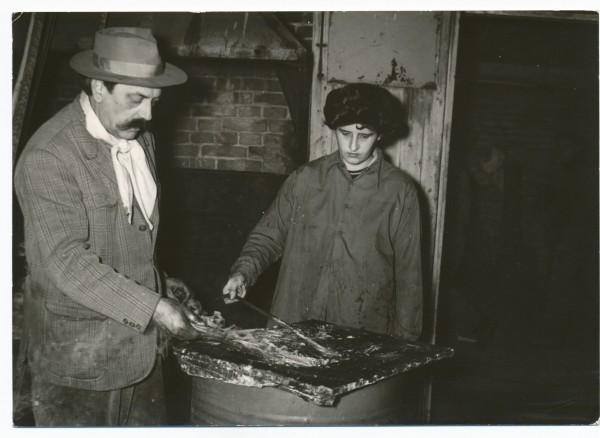Pinot Gallizio on:
[Wikipedia]
[Google]
[Amazon]
 Giuseppe Pinot-Gallizio (1902–1964) was an Italian painter, the formulator of industrial painting, and a founding member of the
Giuseppe Pinot-Gallizio (1902–1964) was an Italian painter, the formulator of industrial painting, and a founding member of the
 Giuseppe Pinot-Gallizio (1902–1964) was an Italian painter, the formulator of industrial painting, and a founding member of the
Giuseppe Pinot-Gallizio (1902–1964) was an Italian painter, the formulator of industrial painting, and a founding member of the Situationist International
The Situationist International (SI) was an international organization of social revolutionaries made up of avant-garde artists, intellectuals, and political theorists. It was prominent in Europe from its formation in 1957 to its dissolution ...
. He was also a scholar of popular culture, archaeology, nomadism, and botany. Mirella Bandini ''an enormous and unknown chemical reaction: the EXPERIMENTAL LABORATORY in ALBA'', published in Elisabeth Sussman (1989) ''On the passage of a few people through a rather brief moment in Time: The Situationist International 1957-1972''
Life
Pinot-Gallizio was born inAlba
''Alba'' ( , ) is the Scottish Gaelic name for Scotland. It is also, in English language historiography, used to refer to the polity of Picts and Scottish people, Scots united in the ninth century as the Kingdom of Alba, until it developed i ...
, Piedmont
it, Piemontese
, population_note =
, population_blank1_title =
, population_blank1 =
, demographics_type1 =
, demographics1_footnotes =
, demographics1_title1 =
, demographics1_info1 =
, demographics1_title2 ...
, where he became an independent Left councilman and a chemist. In 1955, he met Asger Jorn
Asger Oluf Jorn (3 March 1914 – 1 May 1973) was a Danish painter, sculptor, ceramic artist, and author. He was a founding member of the avant-garde movement COBRA and the Situationist International. He was born in Vejrum, in the northwest c ...
, with whom he co-founded the Experimental Laboratory of the Imaginist Bauhaus in Alba, which was part of the International Movement for an Imaginist Bauhaus
The International Movement for an Imaginist Bauhaus was a small European avant-garde artistic tendency that arose out of the breakup of COBRA, and was initiated by contact between former COBRA members Asger Jorn and Enrico Baj and Sergio Dange ...
, in opposition to the return to productivism
Productivism or growthism is the belief that measurable Productivity (economics), productivity and economic growth, growth are the purpose of human organization (e.g., work), and that "more production is necessarily good". Critiques of product ...
by others in the Bauhaus
The Staatliches Bauhaus (), commonly known as the Bauhaus (), was a German art school operational from 1919 to 1933 that combined crafts and the fine arts.Oxford Dictionary of Art and Artists (Oxford: Oxford University Press, 4th edn., 200 ...
school, in particular Max Bill
Max Bill (22 December 1908 – 9 December 1994) was a Swiss architect, artist, painter, typeface designer, industrial designer and graphic designer.
Early life and education
Bill was born in Winterthur. After an apprenticeship as a silversmith ...
. It was held in Pinot-Gallizio's studio, a monastery from the seventeenth century, and was attended by such artists as Enrico Baj who experimented with nuclear painting techniques, Walter Olmo, who experimented with musical interventions, Ettore Sottsass, Elena Verrone, and Piero Simondo.
Pinot-Gallizio drew from his background as a chemist in developing new painting techniques. In 1956 he, along with Jorn, organized the First World Congress of Free Artists
First or 1st is the ordinal form of the number one (#1).
First or 1st may also refer to:
*World record, specifically the first instance of a particular achievement
Arts and media Music
* 1$T, American rapper, singer-songwriter, DJ, and reco ...
, at which a representative from the Lettrist International
The Letterist International (LI) was a Paris-based collective of radical artists and cultural theorists between 1952 and 1957. It was created by Guy Debord and Gil J. Wolman rejoined by Jean-Louis Brau and Serge Berna as a schism from Isido ...
spoke, foreshadowing the foundation of the Situationist International in 1957 by members of both groups, including Pinot-Gallizio. At this conference the Italian artists withdrew from the Laboratory, and after the formation of the SI only Pinot-Gallizio and his son, Giors Melanotte, remained. He helped to make the SI known in the art world with an exhibition in Paris in 1959.Peter Wollen
Peter Wollen (29 June 1938 – 17 December 2019) was a Film theory, film theorist and filmmaker. He studied English at Christ Church, Oxford. Both Political journalism, political journalist and film theorist, Wollen's ''Signs and Meaning in the ...
''Bitter Victory: The Art and Politics of the Situationist International'', published in Elisabeth Sussman (1989) ''On the passage of a few people through a rather brief moment in Time: The Situationist International 1957-1972''
He left the SI in 1960 as it became focused on political, rather than artistic, action. He died in Alba in 1964, and the laboratory continued its work until his death.
Works
Many of Pinot-Gallizio's works were industrial paintings. Rather than a small image to be interpreted, these huge canvases were intended to cover a large area. The first of these was thecavern of anti-matter
A cave or cavern is a natural void in the ground, specifically a space large enough for a human to enter. Caves often form by the weathering of rock and often extend deep underground. The word ''cave'' can refer to smaller openings such as sea ...
, prepared in 1957 after the formation of the SI. It was composed of 145 meter canvases which were painted by hand or with the aid of spray guns and machines using resins invented by Pinot-Gallizio himself. It was displayed at the Galerie René Drouin in 1959, draped around the gallery and sold by the meter.
References
{{DEFAULTSORT:Pinot Gallizio 1902 births 1964 deaths People from Alba, Piedmont Situationists 20th-century Italian painters Italian male painters